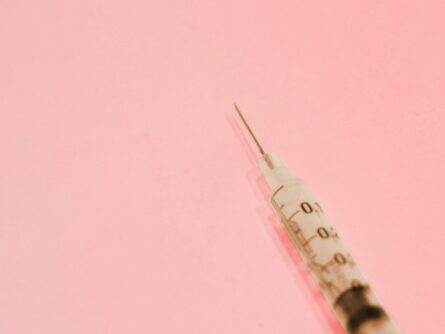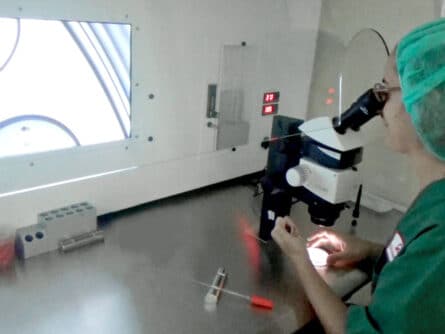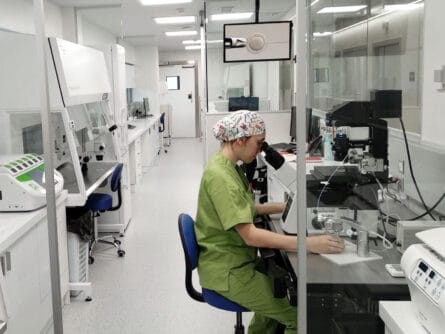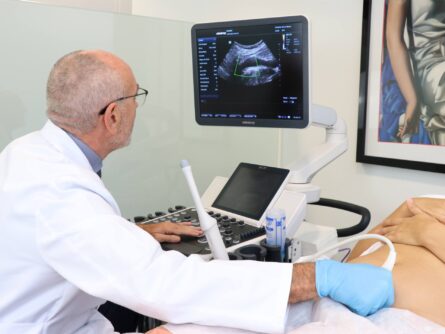What is the ROPA method?
Reception of oocytes from the partner (ROPA) is an assisted reproduction technique carried out in same sex female couples which makes it possible for both women to participate in the process of conception and pregnancy. One woman provides the eggs and the other receives the embryos, gets pregnant and delivers their baby.
The partner’s eggs are fertilised with donor sperm in the laboratory using sperm microinjection (ICSI).

What is the ROPA process like?

Ovarian stimulation
This begins on the second or third day of menstruation. For the woman who will provide the eggs, preparation involves stimulating the ovaries in order to produce mature eggs. At the same time, her partner’s endometrium will be prepared to receive the embryos. Both women will undergo 2 or 3 ultrasound scans over the course of the 12 to 14 day process.

Egg retrieval
The egg retrieval procedure is performed through the vagina and light sedation is used. The aspirated liquid is processed by the laboratory where the eggs are obtained. That same day, the partner who will receive the embryos begins taking progesterone so that her endometrium becomes receptive to the embryos which will be transferred a few days later.

Fertilisation and embryo culture
Fertilisation is always performed using sperm microinjection (ICSI). This is a technique in which the spermatozoids are injected into the eggs with the help of a microneedle. Following this process the embryos will remain in the laboratory for a few days until the embryologists have determined the best moment for their transfer. Special laboratory techniques may be used in certain cases to improve results.

Treatment for the recipient
The recipient’s treatment will begin at the same time or a few days before her partner’s start date so that the two women are synchronised. In this case, the first ultrasound scan will be performed around the time of menstruation and then one or two more ultrasounds will be done over the coming days. This way, the doctor will be able to determine the moment at which the endometrium has reached the ideal thickness for an embryo to implant and for the pregnancy to progress as expected.
What will my treatment be like if I don’t live in Spain?
We know that when a woman decides she wants to become a mother she is making one of the most important decisions of her life. Because the desire to be a mother is one that crosses all races, languages and borders, our International Department wants to be by your side when you need it most in order to make your journey as pleasant as possible. Our International Department is made up of native coordinators who will accompany you before, during and after your pregnancy.
We’ll assign you a doctor and a native coordinator
Who will assist you in your native language from the moment you first contact us.
You’ll only need to make one trip to Spain
Which you’ll be able to arrange far enough in advance so that you can book hotels, flights and time off from work. The rest of your appointments can be carried out remotely: by video-call, phone or email.
1st visit is cost-free
If you’d like to meet us in person and undergo all of the preliminary testing with us.
Preliminary testing and ultrasounds during treatment
This can also be done in your country with your gynaecologist. We’ll send you all the necessary instructions.
We’ll adapt to you.
With the necessary resources to get started once you’re ready. No waiting times.
Success rates
Success rates at Ginemed are around 65% for double embryo transfers carried out at blastocyst stage, confirmed by a positive Beta HCG. At any rate, success rates mainly depend on the age of the woman who provides the eggs as well as the reasons why this type of treatment was recommended. Results also vary according to the number of embryos transferred.
The risk of miscarriage or fetal abnormalities once a pregnancy has been achieved is the same as in a natural pregnancy achieved without medical assistance.
Pregnancy rates by Beta HCG
First fertility visit is free
Request your first appointment cost-free at the clinic closest to you
Frequently asked questions about the ROPA method
Patients are advised to undergo the ROPA technique in the following cases:
- The patient who will be providing the eggs has a good ovarian reserve. This is necessary in order to obtain a good number of eggs which will in turn result in an acceptable number of embryos, some of which will be able to implant and lead to a viable pregnancy.
- Absence of genetic abnormalities in the patient who will be providing the eggs. Likewise, this patient’s karyotype will be analysed (the chromosome count) which, with a blood test, makes it possible to rule out structural or numerical abnormalities in the patient’s chromosomes.
- Absence of uterine abnormalities in the patient who will undergo the embryo transfer. Appropriate uterine anatomy is a must so that the embryo can properly implant and continue developing inside the uterus.
Over the years, society has progressed and family models have become increasingly diverse. For that reason, and thanks to assisted reproduction techniques, homoparental families can also make their dream of becoming mothers come true.
Treatments are diverse depending on the patients’ case and will always require the use of donor sperm. Sperm donors in Spain are anonymous by law, but you will be able to select the physical characteristics you’d like your donor to have.
The most straightforward treatment to achieve a pregnancy is Artificial Insemination, which consists in placing sperm inside the female’s uterus.
If you’re over 38 years of age or your clinical case requires it, the technique of choice may be In Vitro Fertilisation: one of the mothers will undergo the ovarian stimulation process to obtain several eggs which will be retrieved, fertilised, and then the resulting embryos will be transferred to the uterus.
Additionally, there is an increasing number of same sex female couples who get pregnant using the ROPA method (Reception of Oocytes from the Partner). This treatment makes it possible for both women to participate in the process of conception and pregnancy: one woman will provide the eggs while the other will receive the embryos, get pregnant and deliver their baby.
The characteristics and features of the baby are going to resemble those of the female who provides the eggs and the male who provides the sperm. If the characteristics of the sperm donor are similar to those of the woman who receives the embryo, then it will be more likely that the baby will bear a resemblance to both women.
To avoid violating the anonymity law concerning gamete donation, the legal services of the Spanish Fertility Society (SEF) recommend that the two women be legally married, thus making it necessary for the couple to provide a marriage certificate.
However, in June of 2020 the SEF took a stance on this issue and stated that: “Access to ROPA treatment cannot be determined based on the marital status of a same sex female couple given that discrimination based on civil status is prohibited by the Law on Reproduction and by the Spanish Constitution”.
When we compare the ROPA technique to IVF with donor sperm, everything is going to fundamentally depend on the age of the woman who is going to provide the eggs and on the particular characteristics of each patient’s case. The younger the woman (who is providing the eggs), the better the results will be. With ROPA, moreover, both women actively participate in the process of maternity.
IVF processes are going to lead to better results than cycles of Artificial Insemination, as the former involves placing embryos directly into the uterine cavity, while the latter consists in depositing sperm into the uterine cavity. Moreover, in IVF cycles a greater number of eggs are obtained than with insemination cycles, meaning we are going to have more embryos and, as a result, greater chances for pregnancy.
